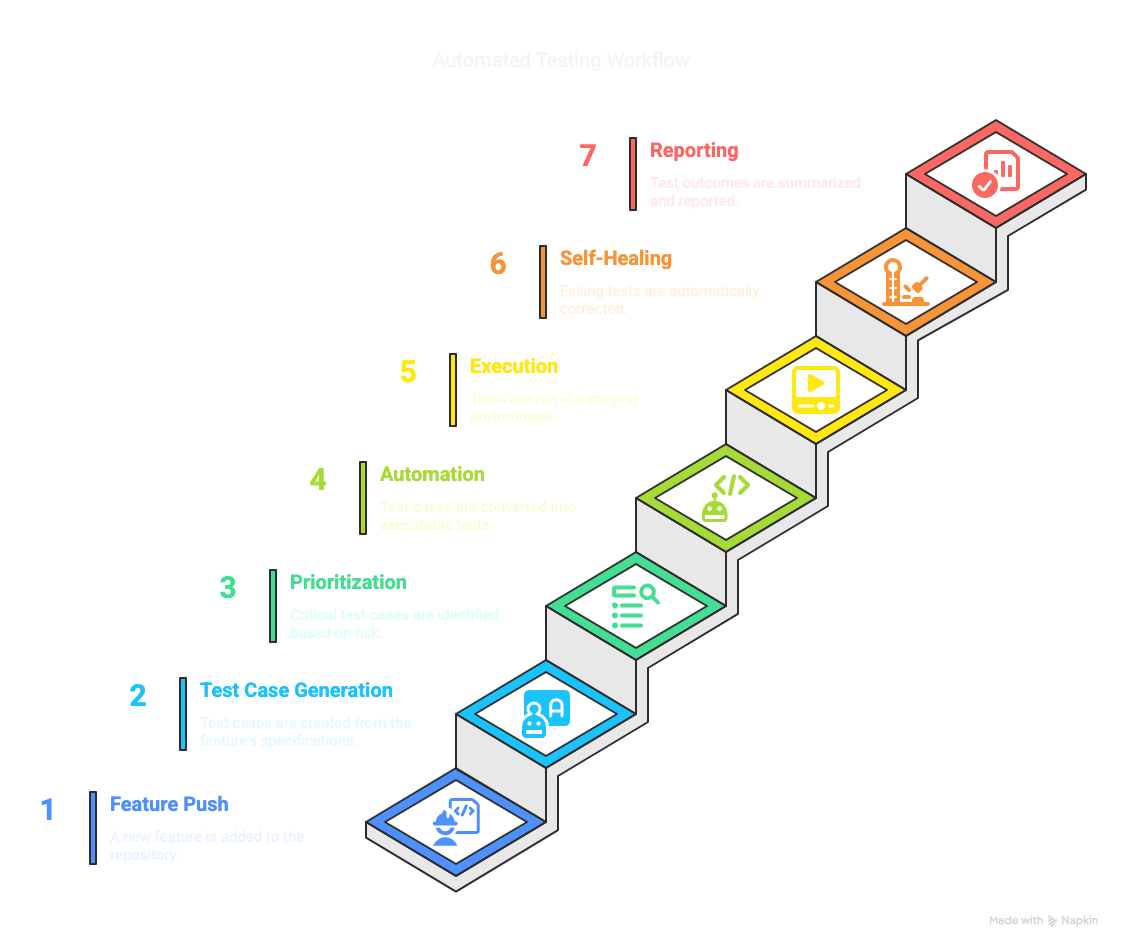- Published on
Harnessing Multi-Agent AI for Smarter QA Workflows
- Authors

- Name
- Ajinkya Kunjir
Introduction
As software systems grow increasingly complex, the need for intelligent, scalable, and adaptive testing strategies becomes critical. One of the most promising innovations in this space is the rise of Multi-Agent AI systems. These systems consist of multiple specialized AI agents that collaborate to automate, optimize, and enhance various stages of the QA lifecycle. This article explores how Multi-Agent AI can revolutionize quality assurance by introducing modular intelligence, autonomy, and coordination.
- What is Multi-Agent AI?
- Key Features of Multi-Agent AI
- Comparison: Single-Agent vs Multi-Agent AI
- Real-World Examples of Multi-Agent AI
- How Multi-Agent AI Can Support QA Workflows
- How Multi-Agent AI Works in Practice
- Sample Workflow
- Benefits of Multi-Agent AI in QA
- Benefits to QA Teams
- Current Industry Use
- Conclusion
What is Multi-Agent AI?
Multi-Agent AI refers to a system where multiple intelligent agents operate independently or cooperatively to achieve individual or collective goals. Each agent has its own area of expertise, and together they mimic a distributed team capable of parallel processing, decision-making, and collaboration.
Key Features of Multi-Agent AI
- Autonomy: Each agent can operate independently without constant oversight.
- Collaboration: Agents can share knowledge, divide tasks, and synchronize results.
- Distributed Processing: Tasks can be handled in parallel, increasing speed and efficiency.
- Scalability: New agents can be added to handle additional complexity or domains.
- Adaptability: Agents learn and adjust behavior based on feedback and changing conditions.
Comparison: Single-Agent vs Multi-Agent AI
| Feature | Single-Agent AI | Multi-Agent AI |
|---|---|---|
| Architecture | Monolithic | Distributed and Modular |
| Task Handling | One agent handles all tasks | Specialized agents handle individual tasks |
| Scalability | Limited | High – agents can be added or scaled dynamically |
| Fault Tolerance | Single point of failure | Redundancy across agents |
| Collaboration | Not applicable | Agents collaborate for efficiency and accuracy |
| Adaptability | Limited contextual awareness | Shared context improves adaptability |
Real-World Examples of Multi-Agent AI
- Customer Support: Multiple bots handle different aspects of a support conversation—billing, tech support, FAQs.
- Autonomous Vehicles: Different AI subsystems manage navigation, obstacle detection, and passenger interaction.
- Game AI: Teams of non-player characters (NPCs) act with different strategies and roles.
- DevOps Automation: Agents manage CI/CD pipelines, monitor infrastructure, and auto-remediate issues.
How Multi-Agent AI Can Support QA Workflows

By breaking down the QA lifecycle into distinct responsibilities, Multi-Agent AI can introduce specialized agents that work together across the pipeline:
Agent Types
Test Case Generation Agent
- Extracts requirements from documents, user stories, or APIs.
- Automatically generates relevant manual and automation test cases.
Test Prioritization Agent
- Analyzes risk, code churn, historical bugs, and test history.
- Ranks and selects high-priority test cases for execution.
Test Automation Agent
- Converts manual test cases into executable scripts for automation frameworks.
- Integrates with test tools to validate stability and coverage.
Execution Orchestrator Agent
- Manages test execution across environments and configurations.
- Monitors runtime metrics and triggers re-runs when needed.
Self-Healing Agent
- Identifies flaky tests or failures caused by UI changes.
- Automatically adjusts selectors, timing, or logic.
Reporting & Insight Agent
- Collects execution data, error logs, and system metrics.
- Generates intelligent summaries, dashboards, and insights.
Security & Compliance Agent
- Scans for vulnerabilities and ensures adherence to compliance standards.
How Multi-Agent AI Works in Practice
These agents communicate through a shared workspace or communication protocol (like message queues, REST APIs, or agent communication languages). They can be orchestrated in a centralized or decentralized architecture:
- Centralized Coordination: A master agent delegates tasks and maintains control over the workflow.
- Decentralized Autonomy: Each agent operates independently, reacting to triggers or changes in shared knowledge.
- Hybrid Models: Combine centralized oversight with decentralized execution.
Sample Workflow

- A new feature is pushed to the repo.
- The Test Case Generation Agent parses the PR and specs to create test cases.
- The Prioritization Agent flags the most critical ones based on risk.
- The Automation Agent converts them into executable tests.
- The Execution Orchestrator Agent runs tests in staging.
- The Self-Healing Agent corrects any failing tests.
- The Reporting Agent summarizes outcomes and alerts the QA lead.
Benefits of Multi-Agent AI in QA
- Scalability through parallelized intelligent workflows.
- Enhanced speed and accuracy in test creation and execution.
- Reduction in manual effort and human error.
- Proactive risk mitigation and defect detection.
- Continuous learning and adaptation to changes in code and behavior.
- Faster feedback loops in CI/CD pipelines.
- Improved visibility and traceability across QA operations.
Benefits to QA Teams
- Efficiency: Teams spend less time on repetitive tasks and more on exploratory and strategic testing.
- Consistency: Standardized outputs across agents lead to fewer oversights.
- Resilience: If one agent fails or falls behind, others can often adapt or compensate.
- Innovation: QA engineers can focus on designing intelligent workflows rather than maintaining brittle scripts.
- Collaboration: Human testers and AI agents can form a cohesive partnership where each complements the other's strengths.
Current Industry Use
- Companies like Microsoft, Meta, and OpenAI explore agent-based simulations and task automation.
- AI-driven testing platforms are adopting agent-based architectures for modularity and resilience.
- Open-source frameworks like LangChain and CrewAI are pioneering multi-agent tooling for various domains.
Conclusion
Multi-Agent AI is not just a futuristic concept; it's a practical, transformative approach to modern QA. By deploying intelligent, autonomous agents tailored to different QA tasks, teams can dramatically enhance their speed, efficiency, and confidence in delivering high-quality software.
Stay tuned for a follow-up article on how to prototype a simple multi-agent QA system using open-source tools.